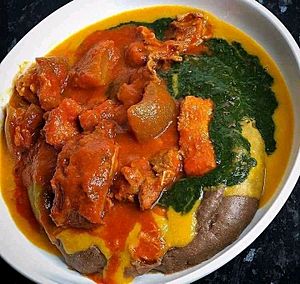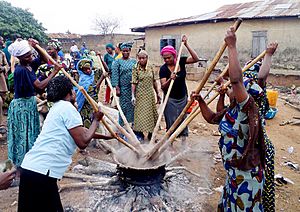Amala (food) facts for kids
Àmàlà is a special food that comes from the Yoruba people in Southwestern Nigeria. It's a bit like a thick dough or paste. People make it from flour that comes from yams, cassava, or even unripe plantains.
To make yam flour, yams are peeled, sliced, cleaned, and then dried. After drying, they are ground into a fine powder. This powder is also called èlùbọ́. Yams are white when fresh, but they turn brown when dried. This is why àmàlà often has a brownish color.
Àmàlà is usually eaten with different kinds of delicious soups. Some popular ones include ewédú (a green leafy soup) and gbẹ̀gìrì (a soup made from black-eyed beans). It can also be served with other soups like ẹ̀fọ́ (vegetable soup), ilá (okra soup), or ogbono soup.
Contents
Types of Àmàlà
There are three main kinds of àmàlà, depending on what flour is used: àmàlà isu, àmàlà láfún, and amala ogede.
Yam Flour Àmàlà (àmàlà isu)
This is the most common type of àmàlà. It is made from dried yam flour. The best type of yam for this is called Dioscorea cayenensis, which has a lot of starch.
Yams grow in many parts of the world, like Africa, Asia, and the Caribbean. Most yams, about 95%, are grown in West Africa. Yams can be eaten in many ways, such as boiled, roasted, or fried. Because fresh yams spoil quickly, they are often dried and made into flour. This yam flour can then be mixed with hot water to make àmàlà.
When dried yam flour is added to boiling water, it turns into a black or brownish dough. Àmàlà isu is full of carbohydrates, which give people lots of energy. Yams are a very important source of energy for many people in West Africa.
Cassava Flour Àmàlà (àmàlà láfún)
The second type of àmàlà is called àmàlà láfún. This one is made from dried cassava flour. In Nigeria, dried cassava flour is known as “lafun.”
Cassava is a woody plant that is very important for food in Nigeria, just like yam. Nigeria is actually the biggest producer of cassava in the world! When cassava flour is used as a dry powder, it makes àmàlà láfún. If cassava is fermented and made into flakes, it becomes another common dish called Garri.
Plantain Flour Àmàlà (Amala ogede)
Another type of àmàlà is called elubo ogede, which means plantain flour. This type is usually lighter in color than the others.
Unripe plantain flour has a low level of carbohydrates. This makes it a good food choice for people who need to eat less sugar, like those with diabetes. To make it, unripe plantains are peeled, dried, and then ground into flour. When this flour is cooked with boiling water, it turns into amala ogede, which is light brown.
How Àmàlà is Made
Àmàlà is made by taking dried yam or plantain peels, or dried cassava, and grinding them into flour. This flour is then slowly added to boiling water and stirred very well until it forms a smooth, thick dough. It takes a lot of stirring to get the right texture!
Soups to Eat with Àmàlà
Àmàlà is almost always eaten with a variety of tasty soups. Here are some of them:
- Egusi: A soup made from thickened melon seeds and leafy vegetables.
- Ewedu soup: Made from cooked and grated Corchorus leaves.
- Okro soup: A slimy soup made from okra.
- Efo riro: A rich vegetable soup often mixed with meat or fish.
- Ogbono soup: Made from ground ogbono seeds, often with stock fish and locust beans.
- Gbegiri soup: A special soup made from dried beans.
See also
 In Spanish: Àmàlà para niños
In Spanish: Àmàlà para niños




